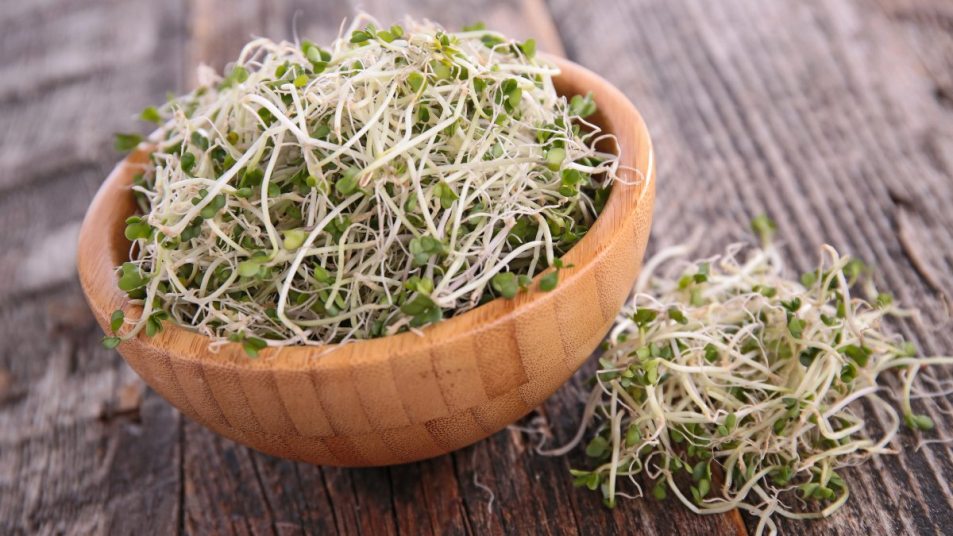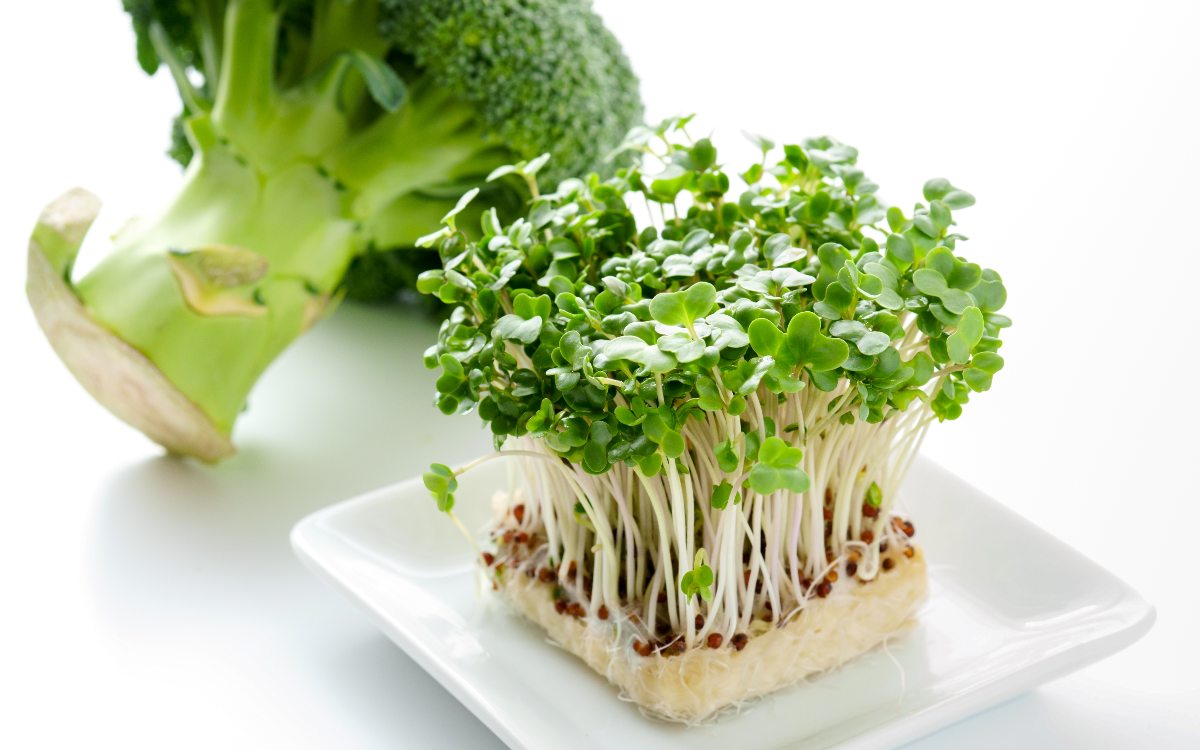Your Guide to Broccoli Sprouts: Nutrition, Health Benefits, Growing at Home, and Recipes

Three years ago during a visit to Ithaca, New York, I bought a sprout sandwich that was possibly the best I’ve ever tasted. It had warm multigrain toast, homemade hummus, roasted red peppers, juicy tomatoes, a drizzle of olive oil, and a thick bed of fresh sprouts. Ever since then, I’ve worked sprouts into my meals whenever possible. I recently started wondering about the benefits of each sprout variety, which led me to investigate one kind in particular: broccoli sprouts.
Surprisingly, broccoli sprouts don’t taste like broccoli. They have a slightly spicy and peppery flavor, and the soft crunch of the white stems make them perfect for salads, sandwiches, and garnishes. But do these tiny vegetables have as many health benefits as their full-grown counterparts? And can you grow them at home? Find the answers to all your sprouting questions below.
What are broccoli sprouts?

Broccoli sprouts are baby broccoli plants. They have brown seedlings at the bottom, white stems, and tiny clover-like leaves at the top. They are typically eaten at just three to five days old.
What is the nutritional content?
The International Sprout Growers Association (ISGA) states that 3 ounces of broccoli sprouts (a little over ⅓ of a cup) contain:
- 35 calories
- 0.5 grams of fat
- 25 milligrams (mg) of sodium
- 5 grams of carbohydrates
- 4 grams of fiber (4 of the 5 grams of carbs are fiber)
- 2 grams of protein
In addition, 3 ounces have about 10 percent of your daily value (DV) of vitamin A, 60 percent DV of vitamin C, 6 percent calcium, and 4 percent iron.
What are the health benefits?
Compared to the sprouts, broccoli offers a similar nutritional content. In other words, equal amounts of broccoli and broccoli sprouts have similar nutritional profiles. There is one key difference, though: the sprouts contain 10 to 100 times more glucoraphanin.
Glucoraphanin is a powerful plant compound found in cruciferous vegetables. It’s a sulfur-containing compound (which explains why broccoli sprouts have a stronger flavor than broccoli), and a type of phytochemical. Phytochemicals are bioactive nutrients in plants with antioxidant properties — they protect plants from various diseases and infections.
The benefits of glucoraphanin for plants can benefit us as well. A 2021 scientific review from Nutraceuticals in Brain Health and Beyond states that glucoraphanin may protect against:
- inflammation
- cell death
- neurodegenerative diseases, such as Alzheimer’s and Parkinson’s
- cancer growth, by promoting the death of cancer cells
In addition, a 2018 study published in the Journal of Clinical Biochemistry and Nutrition found that eating broccoli sprouts daily improved the bowel habits of human participants, while alfalfa sprouts did not. And it wasn’t because of the fiber content in broccoli sprouts — though that is helpful, too.
The real reason: Glucoraphanin turns into a compound called sulforaphane in the body, and sulforaphane relieves chronic oxidative stress, which can cause constipation. Oxidative stress is an imbalance of free radicals and antioxidants in your body. Too many free radicals can cause excess cell damage. (Click through to learn why broccoli sprouts are one of the best foods for constipation.)
When are they in season?
Broccoli sprouts can grow year round, as they are best grown indoors. Sprouts grown outdoors do well in temperatures between 65 and 70 degrees Fahrenheit (but it’s much trickier to grow them outdoors, and most people start the seedlings indoors anyway). If you want to grow your sprouts inside, keep in mind that they need a cool, dark place that’s about 68 to 78 degrees Fahrenheit.
How do you grow them?
Growing broccoli sprouts doesn’t take long, but it does require a watchful eye. To do it, follow these steps from the FoundMyFitness YouTube channel.
- On the first day, fill a sprouting jar — such as a mason jar with a strainer lid — with water and a bacteria-killing solution. (A drop of dish soap and a tablespoon of apple cider vinegar does the trick.)
- Add 3 to 7 tablespoons of seeds to the water, soap, and vinegar. Stir and let sit for 10 minutes.
- Rinse the seeds very well (about 10 times!) to remove all the soap. Then, fill the jar with fresh water.
- Let the seeds and water sit at room temperature for about 8 hours overnight.
- In the morning, drain the seeds very well. Place the jar at an angle, tilted downward, in a bowl to continue letting the water drain for about 10 minutes.
- For two to five days, rinse the sprouts twice a day in the manner described above. (Drain out all the water each time you rinse.)
- Watch your seeds grow, and harvest after three to five days total.
For a visual demonstration, watch the full video below.
How can I add them to my meals?
Looking for some delicious ways to add broccoli sprouts to your diet? These are my favorite recipes:
- Sprout sandwich. (I had to mention it again.) This is very customizable based on the veggies in your kitchen. One of my favorite easy combinations: whole grain bread, hummus, sliced cucumbers, arugula, sprouts, olive oil, and pepper.
- Soup or salad garnish. Elevate any soup or salad with a sprinkle of sprouts. Try them on top of this zingy tuna pasta salad, or this creamy goat cheese and chive wedge salad.
- Smoothie. If you aren’t fond of that sharp, peppery flavor, blend a ⅓ cup of sprouts into your morning smoothie. Strong tropical flavors like mango or pineapple will mask the taste, but you’ll still get all the health benefits.
How will you enjoy your sprouts this season?












